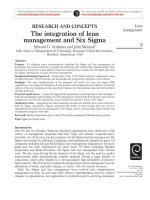The architecture of computer hardware and systems software an information technology approach ch15p2
Bạn đang xem bản rút gọn của tài liệu. Xem và tải ngay bản đầy đủ của tài liệu tại đây (383.15 KB, 20 trang )
Chapter 15 – Part 2 Networks
The Internal Operating System
The Architecture of Computer Hardware
and Systems Software:
An Information Technology Approach
3rd Edition, Irv Englander
John Wiley and Sons
2003
Network Basics
Communication paths
Protocol standards
Data transmission
By character or byte at a time
By sending the entire message at a time
By subdividing the messages into packets and
sending each packet at a time
Frames are packets that have been further
subdivided to meet requirements of the media
access control hardware protocol
Chapter 15
15.2-2
Packet Header
Also known as the preamble
Contains
Description of the packet
Destination address of receiver
Source address of sender
Information about the data being sent
Chapter 15
15.2-3
Advantages of Packets
Reduces communication overhead
Reasonable unit for routing of data
Alternative to dedicating a channel for the entire length
of the message
Packets from several sources can share a single
channel
Each sender/receiver pair appears to have a channel
to itself
Receiving computer can process an entire block of
data instead of a character or byte at a time
Simplifies synchronization of the sending and receiving
systems by providing clear start and stop points
Chapter 15
15.2-4
OSI Reference Model
Open Systems
Interconnection
Model
Developed by International
Standards Organization
(ISO)
Contains seven layers
All People Seem To Need
Data Processing
People Do Not Through
Sausage Pizza Away
Chapter 15
Application
Presentation
Session
Transport
Network
Data Link
Physical
15.2-5
Layers of the OSI Model
Chapter 15
15.2-6
OSI Physical Layer
Responsible for transmission of bits
Implemented primarily through
hardware
Encompasses signaling method,
electrical and mechanical interfaces
Example: RS-232, 10Base5
Chapter 15
15.2-7
OSI Data Link Layer
Responsible for error-free, reliable
transmission of data
Frames sized for compatibility with the
MAC protocol
Flow control, error detection and
correction, retransmission
Uses MAC addresses
Chapter 15
15.2-8
OSI Network Layer
Responsible for addressing and routing of
messages to final destination
Breaks up messages into frames that meet the
requirements of intervening networks
Local network – no routing
Physical address is appended to each packet
Symbolic addresses are converted to physical
address through a lookup table
External network – routing required
External tables are used to assist in routing
message
Chapter 15
15.2-9
OSI Transport Layer
Ultimate final address of destination is determined
All end-to-end communication including intermediate
nodes
Chapter 15
15.2-10
OSI Session Layer
Establishes a dialogue between two
applications or processes between
systems
Terminates connection at end of
session
Manages logins, password
exchange, logoffs
Chapter 15
15.2-11
OSI Presentation Layer
Provides format and code conversion
services
Examples
File conversion from ASCII to Unicode
Encryption, decryption
Data reformatting
Conversion between data formats used by
different email systems
Chapter 15
15.2-12
OSI Application Layer
• Provides utilities and tools for
application programs and users
Chapter 15
15.2-13
TCP/IP
Transmission Control Protocol/Internet Protocol
Physical and Data Link layers are not specified by
the TCP/IP protocol
Internet Protocol
Implemented in workstations and routers
Messages are segmented into packets and are reassembled at the other end
Uses IP for addressing and routing between networks
Transport
Reliable end-to-end connectivity
Final delivery of packets
Application
Chapter 15
15.2-14
TCP & UDP
Most TCP/IP applications use TCP for
transport layer
TCP provides a connection (logical
association) between two entities to regulate
flow check errors
UDP (User Datagram Protocol) does not
maintain a connection, and therefore does not
guarantee delivery, preserve sequences, or
protect against duplication
Chapter 15
15.2-15
Comparison of OSI and TCP/IP
Chapter 15
15.2-16
Network Services
Protocol Stacks
Sockets
Network file transfers
Print services
Web services
Messaging services
Application program access to network services
RPC – remote procedure calls
Security and network management services
Remote processing and login services
Chapter 15
15.2-17
Network File Transfers
FTP
Internet file transfer protocol
Logical names for machine or drive
Windows
Network files can be accessed
transparently by being mounted directly
into the current file system
Unix / Linux
Chapter 15
15.2-18
Access for a Networked
Operating System
Chapter 15
15.2-19
Network Systems
Distributed system
Collection of independent computers that appear
to the users of the systems as a single computer
Client-Server system
Control is centralized in the server computer
Client computers have network access limited to
services provided by the servers
Peer-to-Peer system
Any two computers can communicate with one
another within security constraints
Chapter 15
15.2-20









